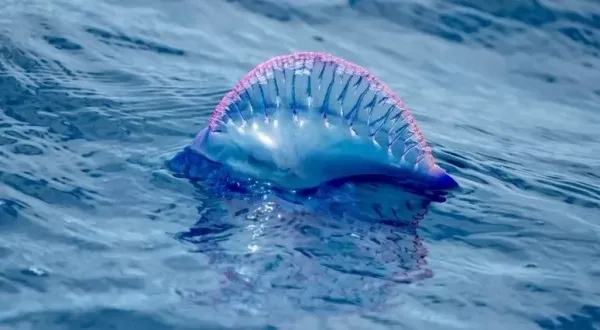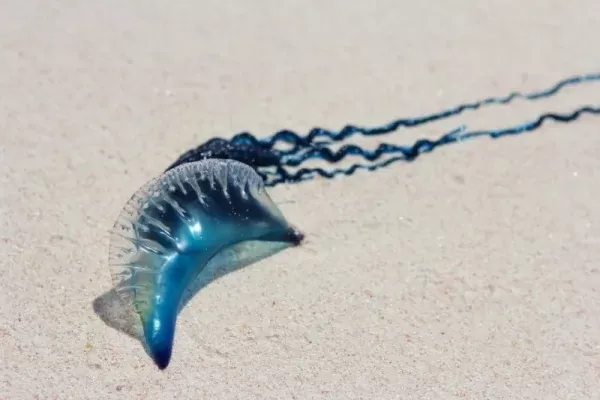Thrilling about Qandil, the man of war
The Portuguese jellyfish is one of the types of jellyfish that often float on the surface of the water as a result of the fullness of its body with gas, and the Portuguese jellyfish jelly cannot move himself in the water, but it moves through the wind only and according to its direction, and the gas that fills the body of this type of The jellyfish consists of oxygen and carbon dioxide in the atmosphere, but the proportion of carbon dioxide constitutes about 90% of the gas present in the body of the Portuguese warman.

The Portuguese War Man's jellyfish may seem to be one being, but they are four different living beings, or quasi-animals, and they cannot work without each other, and each one provides a necessary function for others to survive, and the object at the top that looks like a bubble is basically a bag full of With gas, it allows the jellyfish man to float on a water surface, and the other two are the sensors of the Portuguese man of jellyfish, who work to feed him. They also work to defend and hunt prey, and the fourth and last being responsible for reproduction.
This sea creature is very similar to the ships the Portuguese navy used in the fifteenth and sixteenth centuries when it was in full sailing condition and this is why this lamp was called this name due to its similarity with the ships, and the name may also refer to the helmets worn by the Portuguese soldiers during the same period

The real jellyfish is one living creature, and not many of them are combined in one being. As a result, the Portuguese man of war jellyfish is a completely different type called the gouge of the pebbles, and the Portuguese man of war jellyfish and jellyfish belong to the same division as they are the cnidaria or stings, but there are also 10,000 other animals
The Portuguese man of war jellyfish may not be a real jellyfish, but he has one characteristic that we usually associate with real jellyfish, which are painful stings, and the Portuguese man of jellyfish's sensors cover many stinging cells, which help the lamp kill its prey which is usually small fish and plankton The bites of the Portuguese man of war jellyfish bites are painful for humans, but they are rarely fatal.
The lamps of the Portuguese man of war, the lampshade of the Portuguese man of war, can reach 165 feet, which can wrap and sting their prey as if they are a whip stroke. Treatments for sharp stings were discussed, but there is a 2017 study in Tuxin magazine that recommended vinegar to wash any remaining stinging cells as soon as the sensors are removed and then soak the area Infected in hot water, the ideal temperature is about 45 degrees Celsius for about 45 minutes

In spite of the terrible Portuguese man jellyfish sting, it can fall quite as prey as any other animal, as both the turtle and the ocean sunfish are eager to prey on the Portuguese jellyfish, which is not surprising because both The two species eat jellyfish in general, and also one of the predators for this type of jellyfish is the cloak octopus, and this large octopus has been seen with the defeated Portuguese war jellyfish hanging in his tentacles, and it is likely that he uses them for both attacking prey and defending himself from predators.
The Portuguese War Man's jellyfish has no means of propulsion, so he is simply drifting with water currents, either riding ocean currents or sailing as airbags that run quickly into sea currents, and if there is a threat on the surface, the Portuguese War Man's jelly can temporarily empty his airbags To dive under the water
Sources : arageek
Write me on steemit here trending : alamrany
If you see that I really deserve support from here
Dogecoin : DKg4DqiBCcmJZqBPPbcudMUhiba1s5BJzA
